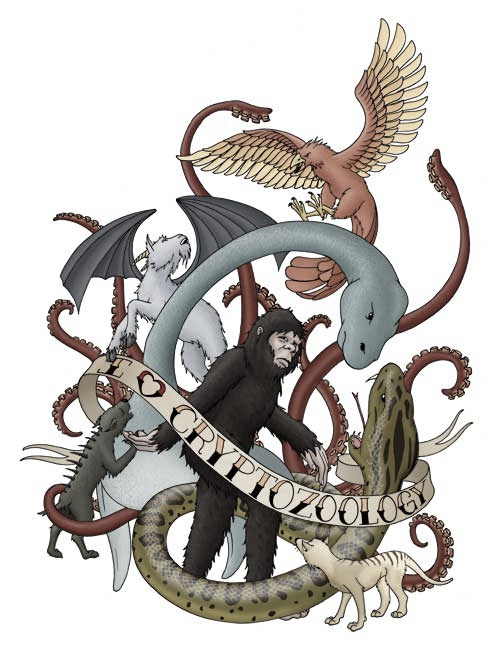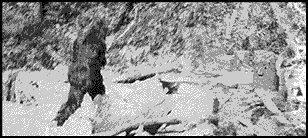
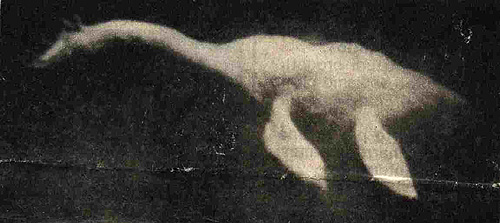
 |
MONSTERS! |  |
Scientists have two major objections to pseudoscientists’ claims concerning the existence and habits of these animals. The first objection is that no valid evidence of any kind has ever been found, to indicate that such an animal actually exists. The second objection is that the places where the animals are said to exist could not support them in the numbers required to prevent them from becoming extinct. In pseudoscientific claims regarding such creatures there are always gross ecological, zoological and herd-size contradictions that render the claims simply impossible. Since no direct evidence of the existence of such animals is ever shown, the attitude of zoologists and other scientists is necessarily one of complete skepticism.
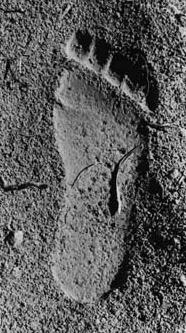 |
Let’s look at some claims in more detail, to see just what kinds of objections these are, and how they arise. Consider Bigfoot or Sasquatch. This is supposed to be a large (7–15 feet tall) ape-like animal with short red-brown or black hair, reported all over the Pacific Northwest, from California to British Columbia. Many organizations and newspapers have offered cash prizes of up to $100,000 for hard evidence that Bigfoot exists, or for a live Bigfoot. Despite this, no evidence has ever been forthcoming. What is put forward in place of real evidence are eyewitness reports of sightings, all vague, all contradictory in major details, and all curiously lacking in specifics; footprints in the snow, no two sets of which look at all alike; recorded Bigfoot “vocalizations,” no two tapes of which sound even vaguely alike; and various photographs and one movie, all of which appear to show someone in a standard costume-shop ape outfit stumbling about in the woods. Compare all this, for example, to the evidence available for the existence of a real, but extremely rare animal— the Giant Panda! |
Discounting the non-existent evidence for Bigfoot, a scientist would ask: how many of these creatures are there? We worry about the gorilla and chimpanzee becoming extinct if the numbers of these animals fall into the hundreds. Thousands of individuals are needed, at a minimum, to prevent a single drought or epidemic from destroying the species. It seems very hard to believe that thousands… or even hundreds… of Bigfeet are active but unseen in woods fairly heavily traveled by tourists. They should be encountered as frequently as bears! What do the Bigfeet eat? Do they live and hunt in groups of 5 to 50 individuals, like chimpanzees, gorillas, and primitive ape-men, or are they solitary like orangutans? Where and how do they live? In trees? In caves? Underwater? How do they fit into the ecology of the region where they’re supposedly found in largest numbers? What do they prey on? What preys on them? Why don’t we find bodies of Bigfeet dead in accidents, killed by predators, run over by cars, dead of illness, dead of old age, etc.?
We haven’t dealt with the most severe zoological problem of all. In an area as vast and varied as North America, we expect many varieties of the same animal; not just “bears,” but black bears, brown bears, grizzly bears, polar bears, etc., etc. Yet in all of North and South America there are no known species of apes; apes are native only to the “Old World”— Africa and Asia. How then do we have this single species of remarkable giant ape (or ape-man) in such a narrow strip of North America, and no other apes anywhere in all of North and South America? We don’t expect apes in this hemisphere any more than we expect to find native American elephants, hippopotami, greater and lesser pandas, komodo dragons, zebras, camels, or kangaroos!
How about the yeti, the abominable snowman? The high Himalayas are not well travelled or extensively explored even today. Isn’t his existence more probable? Nope. We can raise exactly the same questions as above, and no answers are forthcoming. No evidence can be found that these creatures exist. British newspaper expeditions to Tibet in the early 1950s brought back the usual meaningless reports of footprints and “sightings.” But a 1960 expedition led by Sir Edmund Hillary found absolutely no physical evidence of such an animal, and also found simple explanations for the bogus “evidence” cited by earlier expeditions. For instance, yeti “scalps” said to be kept in inaccessible monasteries turned out to be ordinary caps made of goat fur, intended for sale to visitors and locals. Recently, DNA analysis of a number of samples asserted to be of yeti fur, demonstrated that all these "yeti" were actually bears.
One of the most famous of all monsters is Nessie, the plesiosaur-like, 20-60 foot long, gray, brown, or black monster of Loch Ness. Right off, the first problem is that Loch Ness is about the last place on earth one would be likely to find such a creature. The Loch is about 20 miles long, but only a mile wide. Its waters are deep and as murky as coffee because of suspended particles of peat; the icy water would be an impossible environment for reptiles, and makes the Loch relatively barren even of fish. Nor is there room for the several hundred or so individuals that a zoologist would expect to form a stable population. Believers in Nessie sometimes claim that the animals actually live in the sea, and only solitary individuals swim up to appear in the Loch. This would require supernatural feats on the part of the animals, since Loch Ness is part of the Caledonian Canal system and there are 19 canal locks between Loch Ness and the open sea! Upstream of the Loch is the large city of Inverness, where the water is only a few feet deep.
As always, the “evidence” for the monster consists only of eyewitness “sightings” of extremely dubious significance, and a number of extraordinarily blurry photographs and indistinct movie footage. The monster’s publicity dates from 1933, when a road around the Loch was resurfaced and the inhabitants of the locality were ready for increased tourist business. Much of the early publicity was based on two famous photographs of the monster, taken at about this time, indeed on April Fool's day 1934, which in fact were later revealed by one of the photographers to be photos of a small head and neck formed from plastic wood and attached to the top of a toy wind-up submarine, but which were reprinted extensively, and still are to this day, as authentic shots of Nessie. Not much more was heard about the monster until 1957, when a book by Constance Whyte revived the story. (This should remind the reader of flying saucer “flaps”… you don’t see anything until you read or hear that you should see something.) A famous bit of newsreel footage made in 1960 shows the “monster” swimming about… looking for all the world like a motorboat, and nothing like a large, swimming animal. The best known, and least impressive, of all Loch monster photographs were obtained by an expedition led by wealthy pseudoscientist Robert Rines in the early 1970s. These shots, taken underwater, showed essentially nothing until a few were supposedly “computer enhanced,” after which a few blurry images that could be just about anything were published. After a bit of photo-retouching, aided by extensive imagination, presto, sharp images of Nessie's head, fins and body emerged! Work on Rines' original photos has indicated that in fact all the photos show nothing other than the bottom or banks of the Loch. There’s been no monster activity since the 1970s, to speak of, until May of 2007 when a painfully-inept video of a swimming otter circulated as a sighting of the “authentic” monster. Over the years a number of very careful and increasingly sophisticated sonar scans of Loch Ness have been made. The most recent and most thorough was sponsored by the BBC in 2003. The largest living thing ever found in any such survey was a fish about 3 feet long. It’s also worth noting that a full-size model of a fanciful Loch Ness monster was lost in the Loch during the filming of the 1968 Billy Wilder motion picture, The Private Life of Sherlock Holmes. So there is at least one monster down there, and it doesn’t need to eat, breed, breathe or swim about. Those are the qualifications that all Loch Ness monsters would need to satisfy, and no living animal is ever going to meet such qualifications.
|
It is not well known that there are just as many reports of such monsters in U.S. and Canadian lakes. There are up to 40 different lakes in the U.S. which have been the site of eyewitness monster reports, ranging from Elizabeth Lake in California to the Old Mill Pond in Trenton, New Jersey! Probably the best known of such monsters is “Champ,” who is supposed to live in Lake Champlain. Canada has the Naitaka, which infests British Columbian lakes. In Lake Okanagan is Ogopogo, and in Lake Manitoba is Manipogo. Photographs of these creatures show considerably more imagination and less skill on the part of the photographer than do Nessie photographs, but they are even less convincing for the same reason. |
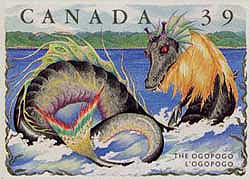 |
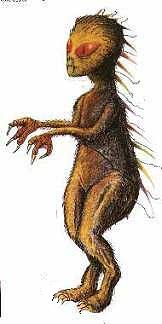 Chupacabra! |
Lake monsters are also reported from Iceland, Norway, Sweden, Lake Van in Turkey, Lake Victoria in East Africa, Lake Kanasi in China, and Lake Baikal in the Soviet Union. At one time, the most famous of these monsters, which appears to prefer rivers to lakes, was the Mokele-Moembe of Africa. It now seems forgotten. The Chinese media until recently censored pseudoscience stories, but in the past few years the lid has come off and media nonsense is growing at an heroic rate, with plentiful reports of China-grown lake monsters and bigfeet. But in the race for worldwide fame, Bigfoot and Nessie run neck and neck, with the Yeti a distant third and the rest so far back in the pack as to be nowhere. Currently Bigfoot pseudoscience has penetrated to Malaysia, where eyewitness "sightings" and fabricated footprints are now epidemic. Bigfoot, under the nickname "Yowie," is also reported from Australia, although since placental mammals never made it to that land, it's the last place on earth one would find an ape! Sea and lake monsters may seem a bit more plausible than forest monsters, since it is far from clear where hundreds or thousands of man-sized monsters could be hiding in any Northern-hemisphere forests remaining in the world today! However, from a strict zoological standpoint, no matter how popular or unpopular a particular monster may be, the probability that any of them actually exist is vanishingly small. And such entries as Mexico's chupacabra and Australia's bunyip are supernatural demons from folklore, not exotic zoological monsters from pseudoscience. |
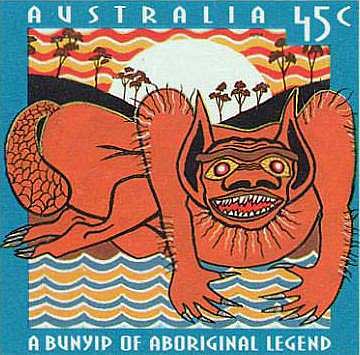 |
Surely millions of monsters could stay hidden in the vasty deeps of the oceans of our planet? Well, hardly. For instance, the Great Sea Serpent was mainly a tall-tale of the age of sail. By 1900, when steam ruled the seas, the great serpent was conspicious only by its absence. During World War I when the seas were full of ships, there was no sea serpent to be seen, and it has been among the missing since.
In no case do we find anything but unsupported claims and taller tales. Never is any actual evidence provided that such creatures exist. One is reminded of a quote from mountaineer James Ramsey Ullman: “As late as the middle 1700s, adventurous travelers would solemnly commend their souls to the Maker before risking the crossing of what today are considered the most prosaic Alpine passes, and to the occasional unhappy wanderer on the higher slopes it was merely a question of whether a bandit, a three-headed dragon, or the ghost of Pontius Pilate would waylay him first.” He goes on to note that, up to 1725, guidebooks to Switzerland contained detailed descriptions and classifications of Alpine dragons. Far travelers have a well-known tendency to dramatize their adventures by inventing mythical beasts they narrowly escaped being devoured by. Probably monsters almost always have their origin in this human tendency, never in the evolution of life on earth. A moving shape in the woods that frightens you might be a bear, might be an owl on a branch, might be imagination, might be anything, but it makes a better story if it's a monster unknown to science! Monster Stories also surely do no harm to the tourist trade; the tourism at Loch Ness is almost entirely based on “your chance at a sight of Nessie,” and every time a motorboat crosses the Loch the tourists are in ecstasy at seeing the monster at long last. You can watch for the Loch Ness monster from the comfort of your living room, on your home computer... just click here!
The sad fact, however, is that the manufactured mystery of monsters is always tawdry and sad and unimaginative put up alongside the many amazing and wonderful animals that are actually known to exist on earth, from pandas to pangolins. If people would transfer some of their enthusiasm for mythical beings into enthusiasm and love for the animals that do exist, and desperately need man’s protection and understanding, we would all find ourselves aware of being in a real world of almost infinite variety and beauty.
Links—
Skeptic's Dictionary entries on Monsters, here. Some popular monsters of the internet. Was Rant Mullins the creator of the Bigfoot legend in the US? Possibly. Another famous generator of Bigfoot prints was Ray Wallace. A brief look at the Yeti, A summary of Bigfoot hoaxes, including the Minnesota Iceman. The BBC debunks Nessie. A Loch Ness fossil hoax. A survey of Loch Ness hoax photos. Australia's bunyip. The White River monster. The Lake Champlain monster. A highly plausible and hilarious explanation for sea monster sightings.
For further reading—
This material was originally written by Rory Coker, Professor of Physics, the University of Texas at Austin.
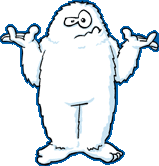 Authentic eyewitness sketch of the Yeti |
 |
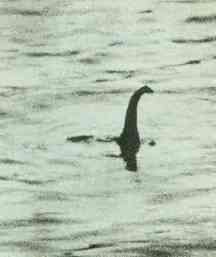 Taken on April 1, 1934! |
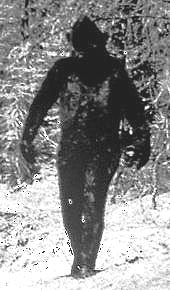 |
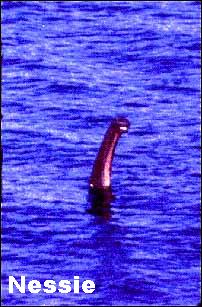 |
|
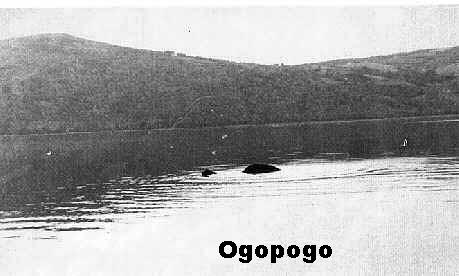 |
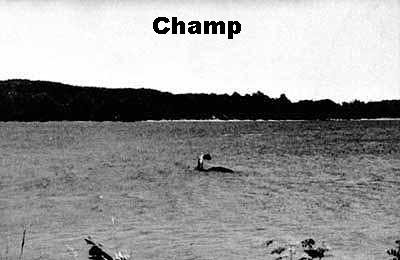 |
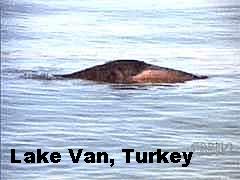 |
It is interesting that in all these photos, the supposedly huge monster is positioned generally about 10 to 20 feet from shore and camera, somehow floating in just a few feet of water, as the perspective of the shots, and the scale of the waves on the lakes unambiguously indicate.
